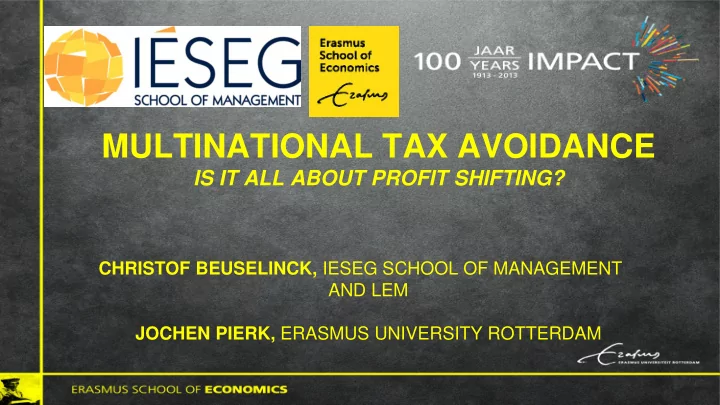

MULTINATIONAL TAX AVOIDANCE IS IT ALL ABOUT PROFIT SHIFTING? CHRISTOF BEUSELINCK, IESEG SCHOOL OF MANAGEMENT AND LEM JOCHEN PIERK, ERASMUS UNIVERSITY ROTTERDAM
WALMART AND TAX SAVINGS What most people think about … What is true as well … $ million 60 70 300 Vendor discounts Captive Real Estate Property tax abatements etc. 2
IN INTROD TRODUC UCTION TION We distinguish between tax avoidance across countries (income shifting) and tax avoidance within countries (local tax avoidance). The purpose of the current study is to investigate whether and if so to what extent MNCs achieve lower consolidated effective tax rates by tax avoidance within countries (subsidiaries). 3
WITHIN-COUNTRY TAX AVOIDANCE Loss affiliates Gramlich, Limpaphayo, and Rhee (2004) Beuselinck and Deloof (2012) Low tax areas Shevlin, Tang, and Wilson (2012) Dyreng, Lindsey, and Thornock (2013) Allowance for corporate equity Hebous and Ruf (2017) IP Boxes regimes Bornemann, Laplante, and Osswald (2017)
SAMPL SAMPLE Data is obtained from the Orbis database (Bureau Van Dijk) Subsidiary and Group data of MNCs of all EU28 countries “Abnormal” GAAP ETR is dependent variable Observations are dropped if pre-tax income is negative values missing observations are from Italy 158,749 subsidiary-year observations (from 69 countries) 34,111 group-year observations (from 27 EU member states) 5
HYPOTHESES H1a: MNC fixed effects (i.e., MNC corporate styles) largely explain subsidiary local tax avoidance strategies. 6
TABLE 3: TABLE 3: REG REGRESSIO RESSION R RESULTS ESULTS - SUBSID SUBSIDIAR IARIES IES Dep. Var.: AETR s (1) NO FE (2) Parent-Country (3) Parent-Sub. Pairs (2) GROUP FE ROA s -0.119*** -0.120*** -0.122*** -0.132*** (53.74) (54.11) (54.20) (54.67) PPE s 0.004*** 0.004*** 0.005*** 0.003** (3.09) (3.16) (3.52) (2.13)* INTANG s 0.035*** 0.036*** 0.039*** 0.04*** (7.21) (7.53) (7.92) (7.62) LEV s 0.023*** 0.023*** 0.024*** 0.027*** (19.63) (19.33) (19.78) (20.58) SIZE s -0.007*** -0.007*** -0.007*** -0.008*** (41.63) (41.49) (40.23) (41.40) LAGLOSS s -0.025*** -0.025*** -0.025*** -0.024*** (22.00) (22.02) (22.01) (20.57) Subs. Country-FE Yes Yes Yes Yes FE No Parent-Country Parent-Subsidiary Country Group N 158,749 158,749 158,749 158,749 R2 – adj. 0.032 0.033 0.040 0.095 R2 0.033 0.034 0.045 0.138 cov( AETR ,FE)/var( AETR ) 0.002 0.012 0.109 R2 explained by FE in % 0.058 0.267 0.789 7
HYPOTHESES H1a: MNC fixed effects (i.e., MNC corporate styles) largely explain subsidiary local tax avoidance strategies. H1b: Subsidiary local tax avoidance is positively associated with MNCs tax avoidance. 8
WITHIN COUNTRY TAX AVOIDANCE: AN EXAMPLE The mean ETR for consolidated statements in a given country/industry/year combination is 20 % (peer group) Taxable income of the peer group is equally earned in 2 subsidiaries among a low-tax country (peer group: 10% ETR, C1) and a high-tax country (peer group: 30% ETR, C2). Group Alpha Group Beta Consolidated Sub-C1 SubA-C2 Consolidated SubB-C1 SubB-C2 PTI 100,000 60,000 40,000 100,000 50,000 50,000 Tax expense 18,000 6,000 12,000 18,000 4,500 13,500 ETR (group) 0.18 0.18 AETR (group) -0.02 -0.02 ETR (subs) 0.10 0.30 0.09 0.27 AETR (subs) 0.00 0.00 -0.01 -0.03 wAETR (subs) 0.00 -0.02 9
TABLE TABLE 6: 6: REG REGRESSIO RESSION R RESULTS ESULTS Dep. Var.: AETR g (1) (2) (3) wAETR s 0.138*** 0.139*** 0.139*** (0.016) (0.016) (0.016) SIZE g -0.004*** (0.001) ROA g -0.280*** (0.032) PPE g 0.002 (0.007) 0.079*** INTANG g (0.022) LEV g 0.030*** (0.005) LAGLOSS g 0.005 (0.005) #SUBS g -0.000** (0.000) ΔTAXINDEX g -0.008** (0.003) PUBLIC g -0.017*** (0.003) Constant 0.001*** -0.004*** 0.052*** (0.000) (0.001) (0.010) Subs. Country-FE No Yes Yes N 34,111 34,111 34,111 R-squared 0.012 0.018 0.066 10
HYPOTHESES H1a: MNC fixed effects (i.e., MNC corporate styles) largely explain subsidiary local tax avoidance strategies. H1b: Subsidiary local tax avoidance is positively associated with MNCs tax avoidance. H2 : The positive association between subsidiary local tax avoidance and MNC group tax avoidance has increased over time. 11
TABLE TABLE 7A: 7A: TIME TIME TREND TREND 12
HYPOTHESES H1a: MNC fixed effects (i.e., MNC corporate styles) largely explain subsidiary local tax avoidance strategies. H1b: Subsidiary local tax avoidance is positively associated with MNCs tax avoidance. H2 : The positive association between subsidiary local tax avoidance and MNC group tax avoidance has increased over time. H3 : Public MNCs within-country tax avoidance behavior is not different from private MNCs within-country tax avoidance behavior. 13
HYPOTHESES H1a: MNC fixed effects (i.e., MNC corporate styles) largely explain subsidiary local tax avoidance strategies. H1b: Subsidiary local tax avoidance is positively associated with MNCs tax avoidance. H2 : The positive association between subsidiary local tax avoidance and MNC group tax avoidance has increased over time. H3 : Public MNCs within-country tax avoidance behavior is not different from private MNCs within-country tax avoidance behavior. H4a : Subsidiary local tax avoidance behavior is more associated with MNC group tax avoidance behavior in domestic subsidiaries versus foreign subsidiaries. H4b : Subsidiary local tax avoidance behavior is more associated with MNC group tax avoidance behavior in vertically integrated subsidiaries versus horizontally integrated subsidiaries. 14
TABLE TABLE 10 10: : RO ROBU BUST STNESS NESS TE TEST STS Dep. Var.: AETR g (1) min 50% (2) min 3 subs. (3) min 7 cluster (4): (1) & (2) & (3) wAETR s 0.282*** 0.155*** 0.140*** 0.191*** (0.037) (0.028) (0.019) (0.047) Controls Yes Yes Yes Yes Subs. Country-FE Yes Yes Yes Yes N 14,920 14,489 26,998 6,247 R-squared 0.100 0.100 0.100 0.100 15
CONCLUSION - MNC corporate style is largely responsible for the tax avoidance of the subsidiaries and MNCs ’ tax avoidance is partly explained by its affiliate tax avoidance and is not originating - exclusively from cross-jurisdictional income shifting. - (+) Time Trend - (+) Domestic subsidiaries - (+) Subsidiaries in a different industry These finding indicates that the nearly exclusive attention on MNC cross-jurisdictional income shifting strategies may be understating the totality tax planning actions of MNCs. 16
Recommend
More recommend